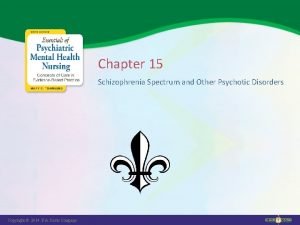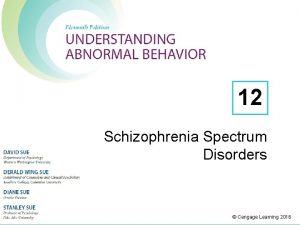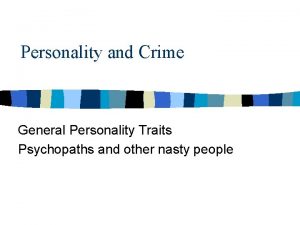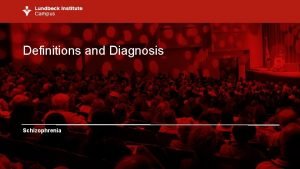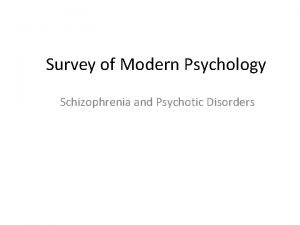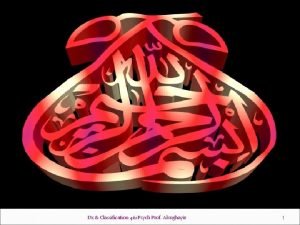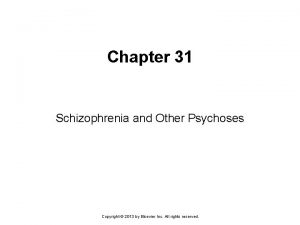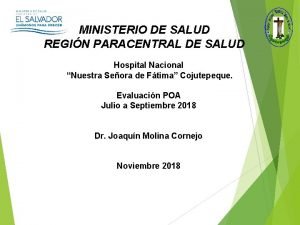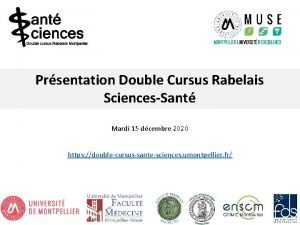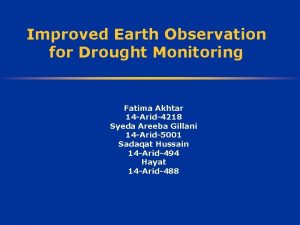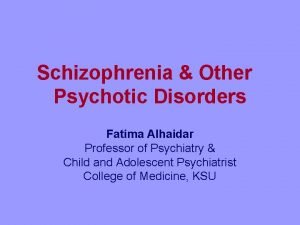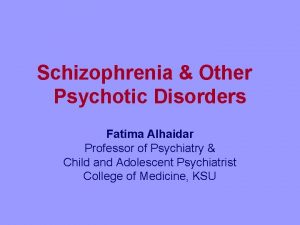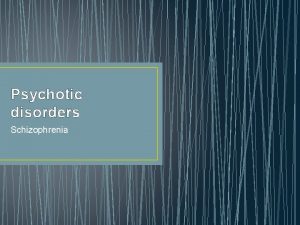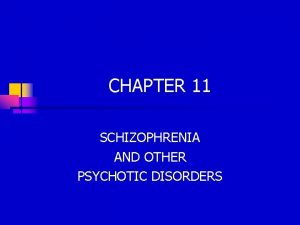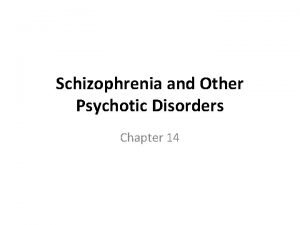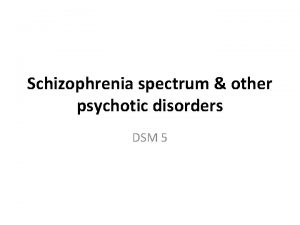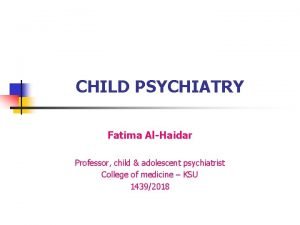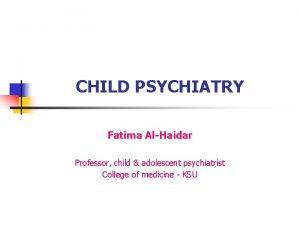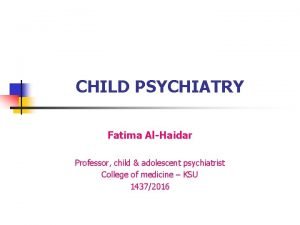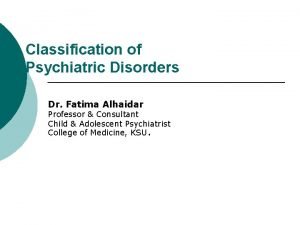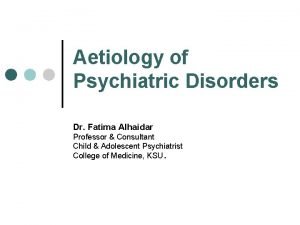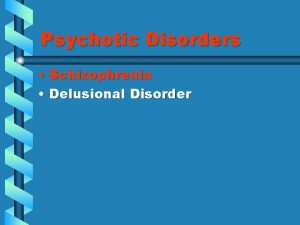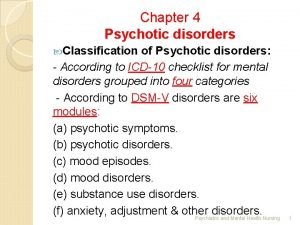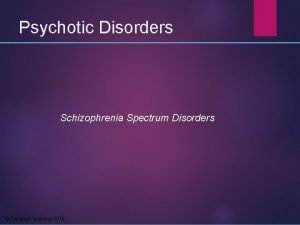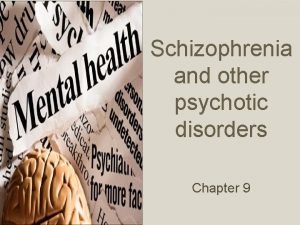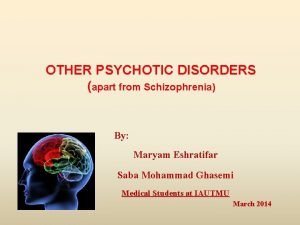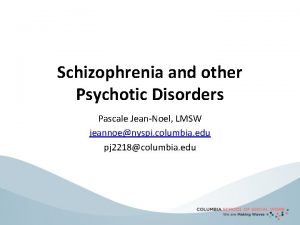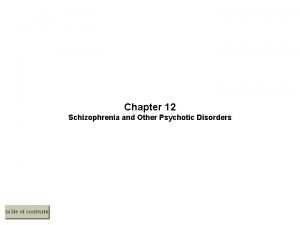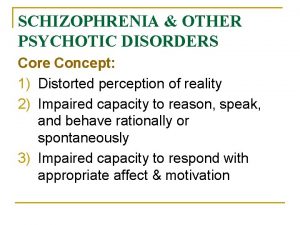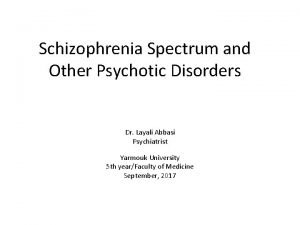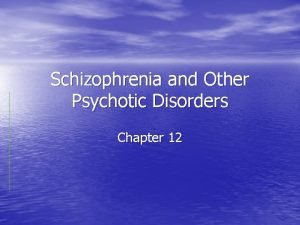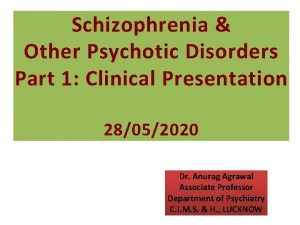Schizophrenia Other Psychotic Disorders FATIMA ALHAIDAR PROFESSOR CHILD





























- Slides: 29

Schizophrenia & Other Psychotic Disorders FATIMA ALHAIDAR PROFESSOR, CHILD & ADOLESCENT PSYCHIATRIST COLLEGE OF MEDICINE, KSU 1434/2013

Schizophrenia - It is not a single disease but a group of disorders with heterogeneous etiologies. - Found in all societies and countries with equal prevalence & incidence worldwide. - A life prevalence of 0. 6 – 1. 9 % - Annual incidence of 0. 5 – 5. 0 per 10, 000 - Peak age of onset are 10 -25 years for ♂ & 25 -35 years for ♀

Clinical Features - No clinical sign or symptom is pathognomonic for schizophrenia Patient's history & mental status examination are essential for diagnosis. - Premorbid history includes schizoid or schizotypal personalities, few friends & exclusion of social activities. - Prodromal features include obsessive compulsive behaviors

- Picture of schizophrenia includes positive and negative symptoms. - Positive symptoms like: delusions & hallucinations. - Negative symptoms like: affective flattening or blunting, poverty of speech, poor grooming, lack of motivation, and social withdrawal.

Subtypes of Schizophrenia § Paranoid type § Disorganized type § Catatonic type § Undifferentiated type § Residual type

Cognitive deficits in schizophrenia

Mental status examination - Appearance & behavior ( variable presentations) - Mood, feelings & affect ( reduced emotional responsiveness, inappropriate emotion) - Perceptual disturbances ( hallucinations, illusions ) - Thought: Thought content ( delusions) Form of thought ( looseness of association) Thought process ( thought blocking, poverty of thought content, poor abstraction, perseveration ) - Impulsiveness, violence, suicide & homicide - Cognitive functioning - Poor insight and judgment

Diagnosis # DSM-IV-TR Diagnostic Criteria for Schizophrenia: A- ≥ two characteristic symptoms 1 - Delusions 2 - Hallucinations 3 - Disorganized speech 4 - Disorganized behavior 5 - Negative symptoms

B- Social / Occupation dysfunction C- Duration of at least 6 months D- Schizoaffective & mood disorder exclusion E- Substance / General medicine condition exclusion F- Relationship to pervasive developmental disorders

Etiology Exact etiology is unknown. 1 - Stress-Diathesis Model; Integrates biological, psychosocial and environmental factors in the etiology of schizophrenia. Symptoms of schizophrenia develop when a person has a specific vulnerability that is acted on by a stressful influence.

2 - Neurobiology Certain areas of the brain are involved in the pathophysiology of schizophrenia: the limbic system, the frontal cortex, cerebellum, and the basal ganglia. a- Dopamine Hypothesis; Too much dopaminergic activity ( whether it is ↑ release of dopamine, ↑ dopamine receptors, hypersensitivity of dopamine receptors to dopamine, or combinations is not known ). b- Other Neurotransmitters; Serotonin, Norepinephrine, GABA, Glutamate & Neuropeptides


c- Neuropathology; Neuropathological and neurochemical abnormalities have been reported in the brain particularly in the limbic system, basal ganglia and cerebellum. Either in structures or connections.



d- Psychoneuroimmunology; ↓ T-cell interlukeukin-2 lymphocytes, abnormal cellular and humoral reactivity to neurons and presence of antibrain antibodies. These changes are due to neurotoxic virus ? or endogenous autoimmune disorder ? e- Psychoneuroendocrinology; Abnormal dexamethasone-suppression test ↓ LH/FSH A blunted release of prolactin and growth hormone on stimulation.

3 - Genetic Factors - A wide range of genetic studies strongly suggest a genetic component to the inheritance of schizophrenia that outweights the environmental influence. - These include: family studies, twin studies and chromosomal studies.


4 - Psychosocial Factors; q In family dynamics studies, no well-controlled evidence indicates specific family pattern plays a causative role in the development of schizophrenia. q High Expressed Emotion family : increase risk of relapse.

Weight of different RF: Family history comes first PLOS Medicine

Course § Acute exacerbation with increased residual impairment § Full recovery: very rare § Longitudinal course: downhill

Prognosis Good P. F 1. Late age of onset 2. Acute onset 3. PPT factor 4. Presence of mood component 5. Good response to TTT 6. Good supportive system 1. 2. 3. 4. 5. 6. 7. 8. Poor P. F Young age of onset Insidious onset Lack of P. T. Multiple relapses Low IQ Pre-morbid personality Negative symptom Positive family history

Differential Diagnosis Nonpsychiatric disorders: Substance-induced disorders Epilepsy ( TLE) CNS diseases Trauma Others Psychiatric disorders: Schizophreniform disorder Brief psychotic disorder Delusional disorder Affective disorders Schizoaffective disorder Personality disorders ( schizoid, schizotypal & borderline personality) Malingering & Factitious disorders

Treatment What are the indications for hospitalization? § Diagnostic purpose § Patient & other's safety § Initiating or stabilizing medications § Establishing an effective association between patient & community supportive systems

Biological therapies - Antipsychotic medications are the mainstay of the treatment of schizophrenia. Generally, they are remarkably safe. Two major classes: Dopamine receptor antagonists ( haloperidol, chlorpromazine ) Serotonin-dopamine receptor antagonists ( Risperidone, clozapine, olanzapine ). - Other drugs: Anticonvulsants Lithium Benzodiazepines Depot forms of antipsychotics eg. Risperidone Consta is indicated for poorly compliant patients - Electroconvulsive therapy (ECT) for catatonic or poorly responding patients to medications

Pharmacolog ical Treatment Algorithm Adapted from the Maudsley prescribing Guidelines (Taylor et al, 2005)

Common side effects of antipsychotic medication (Taylor et al, 2005)

Psychosocial therapies § § § Social skills training Family oriented therapies Group therapy Individual psychotherapy Assertive community treatment Vocational therapy

 Associative looseness
Associative looseness 3ème prophétie de fatima - secret de fatima
3ème prophétie de fatima - secret de fatima Chapter 12 schizophrenia spectrum disorders
Chapter 12 schizophrenia spectrum disorders Is schizophrenia on a spectrum
Is schizophrenia on a spectrum Psychopath trait
Psychopath trait Psychotic disorder
Psychotic disorder Types of delusion
Types of delusion Difference between psychosis and neurosis
Difference between psychosis and neurosis Chapter 31 schizophrenia and other psychoses
Chapter 31 schizophrenia and other psychoses Promotion from associate professor to professor
Promotion from associate professor to professor Bipolar and other related disorders
Bipolar and other related disorders Bipolar and other related disorders
Bipolar and other related disorders Amerstop
Amerstop Fatima ford
Fatima ford Ziarat fatima zahra
Ziarat fatima zahra Fatima turek
Fatima turek Hospital nuestra señora de fatima cojutepeque
Hospital nuestra señora de fatima cojutepeque Rabelais
Rabelais Fatima map
Fatima map Rugaciunea de la fatima
Rugaciunea de la fatima Venovi dijagrami zadaci
Venovi dijagrami zadaci Secret fatima
Secret fatima Landscape elements
Landscape elements Fatima zribi
Fatima zribi Caso bruna viana
Caso bruna viana Apparition de marie à fatima
Apparition de marie à fatima Fatima driouech
Fatima driouech Fatima kadric
Fatima kadric Syeda areeba fatima biography
Syeda areeba fatima biography Historia fatimy
Historia fatimy
